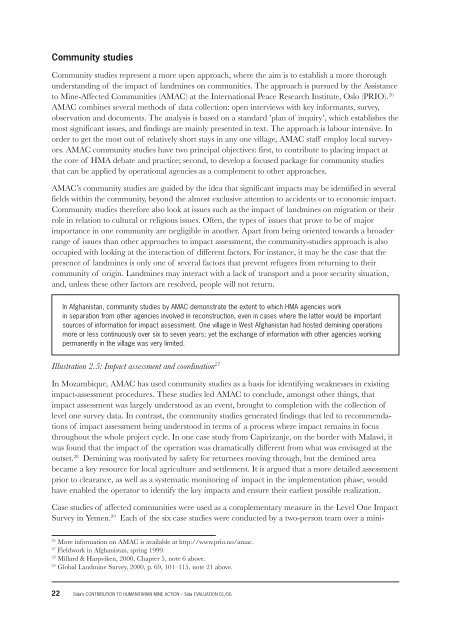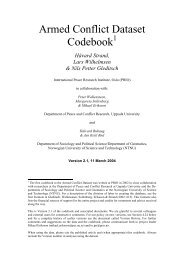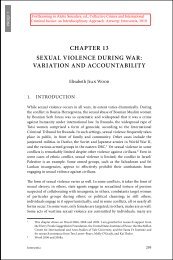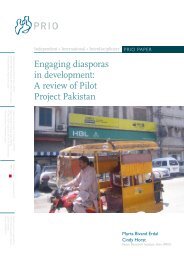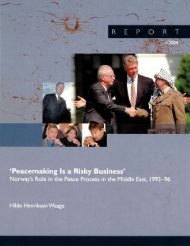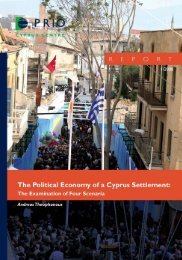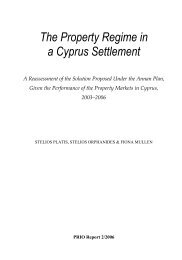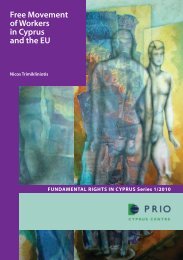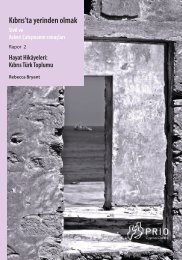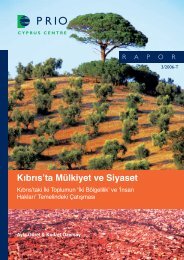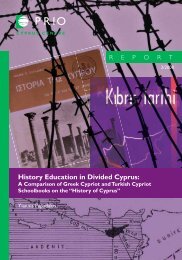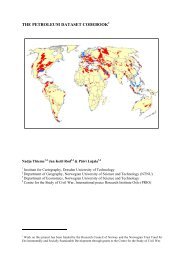Community studiesCommunity studies represent a more open approach, where the aim is <strong>to</strong> establish a more thoroughunderstanding of the impact of landmines on communities. The approach is pursued by the Assistance<strong>to</strong> <strong>Mine</strong>-Affected Communities (AMAC) at the International Peace Research Institute, Oslo (PRIO). 26AMAC combines several methods of data collection: open interviews with key informants, survey,observation and documents. The analysis is based on a standard ’plan of inquiry’, which establishes themost significant issues, and findings are mainly presented in text. The approach is labour intensive. Inorder <strong>to</strong> get the most out of relatively short stays in any one village, AMAC staff employ local surveyors.AMAC community studies have two principal objectives: first, <strong>to</strong> contribute <strong>to</strong> placing impact atthe core of HMA debate and practice; second, <strong>to</strong> develop a focused package for community studiesthat can be applied by operational agencies as a complement <strong>to</strong> other approaches.AMAC’s community studies are guided by the idea that significant impacts may be identified in severalfields within the community, beyond the almost exclusive attention <strong>to</strong> accidents or <strong>to</strong> economic impact.Community studies therefore also look at issues such as the impact of landmines on migration or theirrole in relation <strong>to</strong> cultural or religious issues. Often, the types of issues that prove <strong>to</strong> be of majorimportance in one community are negligible in another. Apart from being oriented <strong>to</strong>wards a broaderrange of issues than other approaches <strong>to</strong> impact assessment, the community-studies approach is alsooccupied with looking at the interaction of different fac<strong>to</strong>rs. For instance, it may be the case that thepresence of landmines is only one of several fac<strong>to</strong>rs that prevent refugees from returning <strong>to</strong> theircommunity of origin. Landmines may interact with a lack of transport and a poor security situation,and, unless these other fac<strong>to</strong>rs are resolved, people will not return.In Afghanistan, community studies by AMAC demonstrate the extent <strong>to</strong> which HMA agencies workin separation from other agencies involved in reconstruction, even in cases where the latter would be importantsources of information for impact assessment. One village in West Afghanistan had hosted demining operationsmore or less continuously over six <strong>to</strong> seven years; yet the exchange of information with other agencies workingpermanently in the village was very limited.Illustration 2.5: Impact assessment and coordination 27In Mozambique, AMAC has used community studies as a basis for identifying weaknesses in existingimpact-assessment procedures. These studies led AMAC <strong>to</strong> conclude, amongst other things, thatimpact assessment was largely unders<strong>to</strong>od as an event, brought <strong>to</strong> completion with the collection oflevel one survey data. In contrast, the community studies generated findings that led <strong>to</strong> recommendationsof impact assessment being unders<strong>to</strong>od in terms of a process where impact remains in focusthroughout the whole project cycle. In one case study from Capirizanje, on the border with Malawi, itwas found that the impact of the operation was dramatically different from what was envisaged at theoutset. 28 Demining was motivated by safety for returnees moving through, but the demined areabecame a key resource for local agriculture and settlement. It is argued that a more detailed assessmentprior <strong>to</strong> clearance, as well as a systematic moni<strong>to</strong>ring of impact in the implementation phase, wouldhave enabled the opera<strong>to</strong>r <strong>to</strong> identify the key impacts and ensure their earliest possible realization.Case studies of affected communities were used as a complementary measure in the Level One ImpactSurvey in Yemen. 29 Each of the six case studies were conducted by a two-person team over a mini-26More information on AMAC is available at http://www.prio.no/amac.27Fieldwork in Afghanistan, spring 1999.28Millard & Harpviken, 2000, Chapter 5, note 6 above.29Global Landmine Survey, 2000, p. 69, 101–115, note 21 above.22 Sida’s CONTRIBUTION TO HUMANITARIAN MINE ACTION – Sida EVALUATION 01/06
mum of two days and were arranged partly <strong>to</strong> serve as a check on the findings from the structuredsurvey and partly <strong>to</strong> supplement the survey results with personal accounts and more comprehensivecommunity profiles. In the Yemen report, findings from the case studies are represented both in appendixform and as illustrations of impact throughout the text. The case studies are drawn on in order <strong>to</strong>warn mine-action planners of the danger of taking the categories in<strong>to</strong> which communities are rankedas their only reference. Community studies are demanding in terms of both labour and competence,and some critics question their relevance as an impact-assessment <strong>to</strong>ol for opera<strong>to</strong>rs on exactly thesegrounds, arguing that the costs outweigh the benefits. In terms of representing local interest, communitystudies are strong. Their relevance is highest at the local level, but the data they generate are difficult<strong>to</strong> aggregate. Therefore, they are not the best basis for statements about a country’s overall mineproblem. Community studies are workable for all phases of a project, but, as a component in a largeroperation, their role would mainly be <strong>to</strong> make a more thorough impact assessment of communitiesidentified as high impact through other approaches. Finally, community studies are adaptable <strong>to</strong> allstages in the process, from emergency <strong>to</strong> development. Ultimately, community studies constitute acomplement <strong>to</strong> other approaches, such as in addressing high-priority communities identified by LOIS.Institutionalizing impact assessmentThe four analytical approaches discussed in this chapter are <strong>to</strong> a large extent subject <strong>to</strong> similar challengesin method, even though they vary widely in terms of analytical focus. In practice, there areundoubtedly differences between the rough minefield visit that normally informs a rule of thumbdecision and the longer presence that underlies community studies, <strong>to</strong> take the extremes. Nonetheless,all approaches face the challenge of collecting data that is as solid as possible, under what are oftendifficult conditions. One challenge is that of building trust with people who have experienced armedconflict and who may also have been subject <strong>to</strong> political control. Without trust, it is difficult <strong>to</strong> collectsolid data. Another problem, relevant <strong>to</strong> most of the countries of concern here, is the lack of secondarydata. A third problem is that the landmine issue is often heavily politicized. Not only will there beac<strong>to</strong>rs with an interest in misrepresenting the mine problem, key ac<strong>to</strong>rs in HMA have formulatedmethodological <strong>to</strong>ols that can only contribute <strong>to</strong> an overestimation of the problem. The response is <strong>to</strong>work on the development of more robust methodological <strong>to</strong>ols, a process that is now under way inseveral of the approaches discussed above.In a community in northern Mozambique, the main settlement and the former village centre had a mine beltbetween them, although safe access was not seen as a problem. People had taken up cultivation in other areasnearby, and the economic importance of demining would be minimal. Nonetheless, people welcomed thedemining warmly, seeing their ability <strong>to</strong> reassert ownership over the nearby village centre, which used <strong>to</strong> be aPortuguese colonial administration, as a matter of importance. Demining was seen as priority, and people rankedit above, or equal <strong>to</strong>, other welfare issues, such as a health post. However, with no direct risk of accidents, andminimal need for the resources freed up by demining, it was essential that the population developed fullconfidence in demining for the operation <strong>to</strong> have any impact. On that assumption, the operation was significantbecause it responded <strong>to</strong> a locally defined need. Unfortunately, confidence in demining has not always beensafeguarded in the same manner as was the case in this operation.Illustration 2.6: Local priorities 30Better <strong>to</strong>ols are not enough; there is also a need <strong>to</strong> develop the competence <strong>to</strong> apply them. It is importantthat impact-assessment initiatives are linked <strong>to</strong> local competence building, and that the personsbeing trained are linked <strong>to</strong> continuing responses. Impact assessment is a process where data is collected30Millard & Harpviken, 2000, Chapter 6, note 6 above.Sida’s CONTRIBUTION TO HUMANITARIAN MINE ACTION – Sida EVALUATION 01/06 23
- Page 4: This report is part of Sida Evaluat
- Page 9 and 10: MDDMEDDSMGMMLSWMoPHMOUMPLANATONDING
- Page 12 and 13: the conclusions of this report is t
- Page 14 and 15: A prime concern with Mine Action Ce
- Page 16 and 17: 3. The coordination of mine action,
- Page 18 and 19: an needs and the needs of victims o
- Page 20 and 21: At the same time as Sida has been o
- Page 22 and 23: er, throughout the data collection,
- Page 24 and 25: Donors may feel that the costs of i
- Page 26 and 27: is genuinely new. 8 At an overall l
- Page 28 and 29: The first attempt to apply a form o
- Page 30 and 31: standard for basic impact surveys.
- Page 34 and 35: and progress monitored in all phase
- Page 36 and 37: 3 Implementation ChannelsOver the p
- Page 38 and 39: cal implementation and management,
- Page 40 and 41: ing that demining has any effect at
- Page 42 and 43: actual response. In an effort to ov
- Page 44 and 45: ecently developed. The approaches t
- Page 46 and 47: A different tool that will be used
- Page 48 and 49: Alternative implementation channels
- Page 50 and 51: appear to have been doing a good jo
- Page 52 and 53: Coordination may at times even be c
- Page 54 and 55: itarian and development effort. Imp
- Page 56 and 57: Two). In terms of coordinating mine
- Page 58 and 59: ased demining of AREA. Another type
- Page 60 and 61: The Kosovo UNMACC took a number of
- Page 62 and 63: would be accredited and tasked by U
- Page 64 and 65: programme. The proposal was backed
- Page 66 and 67: The present landscape of Swedish ac
- Page 68 and 69: demining purposes. Buoyed by a wave
- Page 70 and 71: given that SRSA also recruits perso
- Page 72 and 73: teams. The need for a breeding capa
- Page 74 and 75: 6 RecommendationsIn the preceding c
- Page 76 and 77: • MACs should operate with agreem
- Page 78 and 79: 7 ConclusionIn this report, we have
- Page 80: 70Appendix 1
- Page 89 and 90:
Ziauddin Operations Officer METADup
- Page 91 and 92:
Bennedich, Claes Department for eva
- Page 93 and 94:
Appendix 3BIBLIOGRAPHYAccelerated D
- Page 95 and 96:
Faulkner, F. & L Pettiford, 1998.
- Page 97 and 98:
McGrath, Rae, 2000. Landmines and U
- Page 99 and 100:
Miscellaneous DocumentsBrady, Justi
- Page 101 and 102:
Appendix 4Sida’s CONTRIBUTION TO
- Page 103 and 104:
Appendix 6• The area must be secu
- Page 105 and 106:
Appendix 7Locality identifier: Dist
- Page 107:
Recent Sida Evaluations00/37:1 Asse


